Qingfeng Li
SpikeVideoFormer: An Efficient Spike-Driven Video Transformer with Hamming Attention and $\mathcal{O}(T)$ Complexity
May 15, 2025Abstract:Spiking Neural Networks (SNNs) have shown competitive performance to Artificial Neural Networks (ANNs) in various vision tasks, while offering superior energy efficiency. However, existing SNN-based Transformers primarily focus on single-image tasks, emphasizing spatial features while not effectively leveraging SNNs' efficiency in video-based vision tasks. In this paper, we introduce SpikeVideoFormer, an efficient spike-driven video Transformer, featuring linear temporal complexity $\mathcal{O}(T)$. Specifically, we design a spike-driven Hamming attention (SDHA) which provides a theoretically guided adaptation from traditional real-valued attention to spike-driven attention. Building on SDHA, we further analyze various spike-driven space-time attention designs and identify an optimal scheme that delivers appealing performance for video tasks, while maintaining only linear temporal complexity. The generalization ability and efficiency of our model are demonstrated across diverse downstream video tasks, including classification, human pose tracking, and semantic segmentation. Empirical results show our method achieves state-of-the-art (SOTA) performance compared to existing SNN approaches, with over 15\% improvement on the latter two tasks. Additionally, it matches the performance of recent ANN-based methods while offering significant efficiency gains, achieving $\times 16$, $\times 10$ and $\times 5$ improvements on the three tasks. https://github.com/JimmyZou/SpikeVideoFormer
GLC-SLAM: Gaussian Splatting SLAM with Efficient Loop Closure
Sep 17, 2024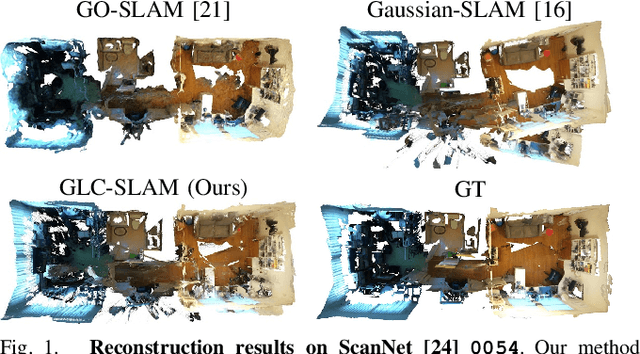
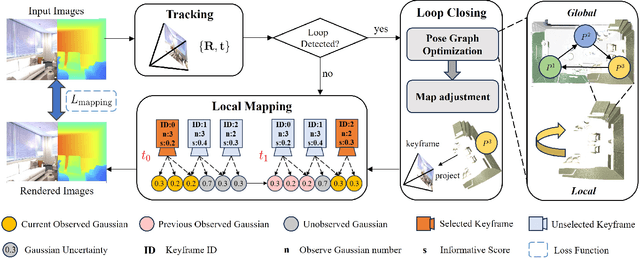
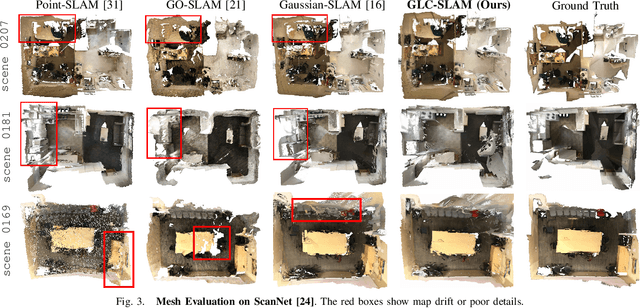
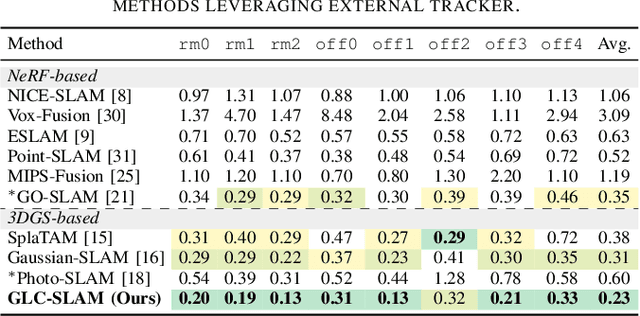
Abstract:3D Gaussian Splatting (3DGS) has gained significant attention for its application in dense Simultaneous Localization and Mapping (SLAM), enabling real-time rendering and high-fidelity mapping. However, existing 3DGS-based SLAM methods often suffer from accumulated tracking errors and map drift, particularly in large-scale environments. To address these issues, we introduce GLC-SLAM, a Gaussian Splatting SLAM system that integrates global optimization of camera poses and scene models. Our approach employs frame-to-model tracking and triggers hierarchical loop closure using a global-to-local strategy to minimize drift accumulation. By dividing the scene into 3D Gaussian submaps, we facilitate efficient map updates following loop corrections in large scenes. Additionally, our uncertainty-minimized keyframe selection strategy prioritizes keyframes observing more valuable 3D Gaussians to enhance submap optimization. Experimental results on various datasets demonstrate that GLC-SLAM achieves superior or competitive tracking and mapping performance compared to state-of-the-art dense RGB-D SLAM systems.
GuidedNet: Semi-Supervised Multi-Organ Segmentation via Labeled Data Guide Unlabeled Data
Aug 09, 2024Abstract:Semi-supervised multi-organ medical image segmentation aids physicians in improving disease diagnosis and treatment planning and reduces the time and effort required for organ annotation.Existing state-of-the-art methods train the labeled data with ground truths and train the unlabeled data with pseudo-labels. However, the two training flows are separate, which does not reflect the interrelationship between labeled and unlabeled data.To address this issue, we propose a semi-supervised multi-organ segmentation method called GuidedNet, which leverages the knowledge from labeled data to guide the training of unlabeled data. The primary goals of this study are to improve the quality of pseudo-labels for unlabeled data and to enhance the network's learning capability for both small and complex organs.A key concept is that voxel features from labeled and unlabeled data that are close to each other in the feature space are more likely to belong to the same class.On this basis, a 3D Consistent Gaussian Mixture Model (3D-CGMM) is designed to leverage the feature distributions from labeled data to rectify the generated pseudo-labels.Furthermore, we introduce a Knowledge Transfer Cross Pseudo Supervision (KT-CPS) strategy, which leverages the prior knowledge obtained from the labeled data to guide the training of the unlabeled data, thereby improving the segmentation accuracy for both small and complex organs. Extensive experiments on two public datasets, FLARE22 and AMOS, demonstrated that GuidedNet is capable of achieving state-of-the-art performance.
NID-SLAM: Neural Implicit Representation-based RGB-D SLAM in dynamic environments
Jan 02, 2024Abstract:Neural implicit representations have been explored to enhance visual SLAM algorithms, especially in providing high-fidelity dense map. Existing methods operate robustly in static scenes but struggle with the disruption caused by moving objects. In this paper we present NID-SLAM, which significantly improves the performance of neural SLAM in dynamic environments. We propose a new approach to enhance inaccurate regions in semantic masks, particularly in marginal areas. Utilizing the geometric information present in depth images, this method enables accurate removal of dynamic objects, thereby reducing the probability of camera drift. Additionally, we introduce a keyframe selection strategy for dynamic scenes, which enhances camera tracking robustness against large-scale objects and improves the efficiency of mapping. Experiments on publicly available RGB-D datasets demonstrate that our method outperforms competitive neural SLAM approaches in tracking accuracy and mapping quality in dynamic environments.
An End-to-end Method for Producing Scanning-robust Stylized QR Codes
Nov 16, 2020
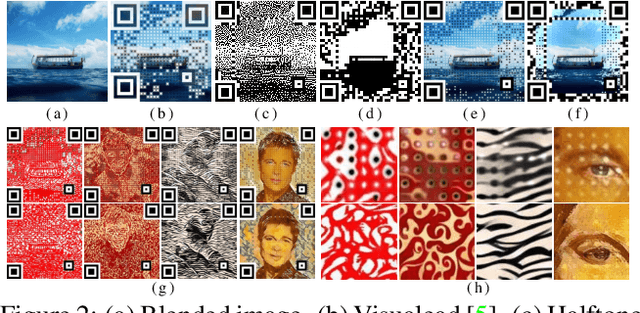
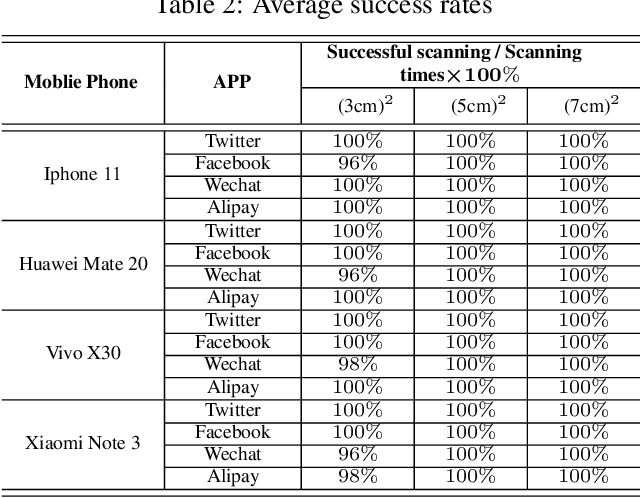

Abstract:Quick Response (QR) code is one of the most worldwide used two-dimensional codes.~Traditional QR codes appear as random collections of black-and-white modules that lack visual semantics and aesthetic elements, which inspires the recent works to beautify the appearances of QR codes. However, these works adopt fixed generation algorithms and therefore can only generate QR codes with a pre-defined style. In this paper, combining the Neural Style Transfer technique, we propose a novel end-to-end method, named ArtCoder, to generate the stylized QR codes that are personalized, diverse, attractive, and scanning-robust.~To guarantee that the generated stylized QR codes are still scanning-robust, we propose a Sampling-Simulation layer, a module-based code loss, and a competition mechanism. The experimental results show that our stylized QR codes have high-quality in both the visual effect and the scanning-robustness, and they are able to support the real-world application.
Unpaired Photo-to-manga Translation Based on The Methodology of Manga Drawing
Apr 22, 2020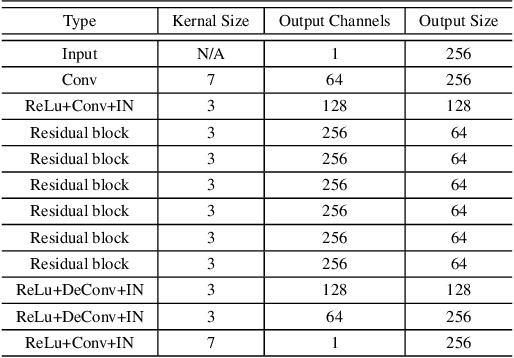
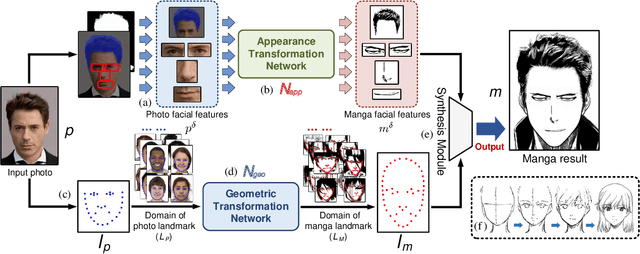
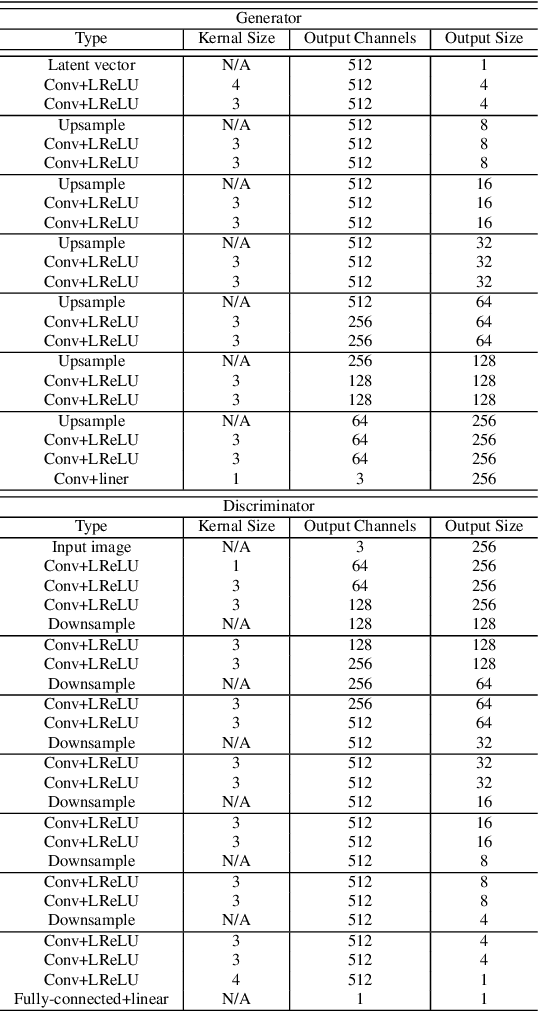
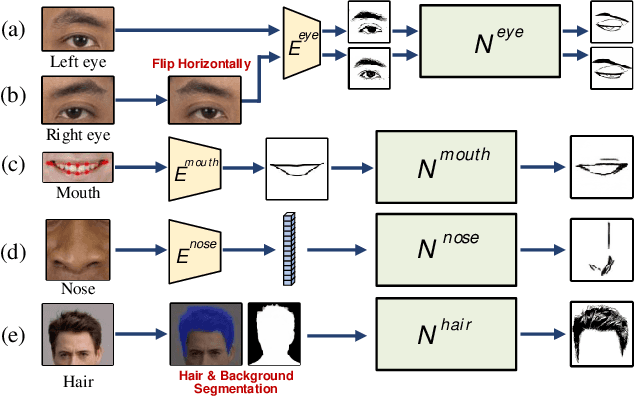
Abstract:Manga is a world popular comic form originated in Japan, which typically employs black-and-white stroke lines and geometric exaggeration to describe humans' appearances, poses, and actions. In this paper, we propose MangaGAN, the first method based on Generative Adversarial Network (GAN) for unpaired photo-to-manga translation. Inspired by how experienced manga artists draw manga, MangaGAN generates the geometric features of manga face by a designed GAN model and delicately translates each facial region into the manga domain by a tailored multi-GANs architecture. For training MangaGAN, we construct a new dataset collected from a popular manga work, containing manga facial features, landmarks, bodies, and so on. Moreover, to produce high-quality manga faces, we further propose a structural smoothing loss to smooth stroke-lines and avoid noisy pixels, and a similarity preserving module to improve the similarity between domains of photo and manga. Extensive experiments show that MangaGAN can produce high-quality manga faces which preserve both the facial similarity and a popular manga style, and outperforms other related state-of-the-art methods.
 Add to Chrome
Add to Chrome Add to Firefox
Add to Firefox Add to Edge
Add to Edge